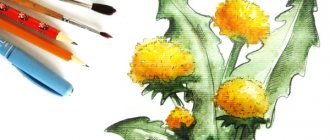Plants that should not be grown in a child's room
The appearance of some plants can cause fear in a child
In addition to useful plants, there are many other decorative and beautifully flowering indoor flowers that are prohibited from growing in rooms where children are present. And they are considered prohibited due to their dangerous substances found in the foliage of the potted flowers themselves. By breaking off a leaf of such a plant and chewing it, you can get poisoning or an unwanted allergic reaction that will appear on the child’s skin in the form of rashes.
Poisonous plants
All kids love to learn new things, they are interested in: what, how and why. Some plant leaves contain poisonous sap, which can cause serious poisoning and allergic reactions.
List of poisonous plants:
- nightshade - after flowering, huge, attractive berries are formed in place of the bolls, which are poisonous to humans
- alocasia – the leaves contain hydrocyanic acid and alkaloids
- oleander is a beautifully flowering plant characterized by the fact that all vegetative parts contain juice that is poisonous to humans
The above plants are not recommended to be grown in children's premises, as well as:
Dieffenbachia
Bush and tall species of Dieffenbachia cannot be grown not only in nurseries, but also in preschool educational institutions
Dieffenbachia is considered the most poisonous indoor flower, since the juice of the leaves is very poisonous. In ancient times, slaves were forced to chew Dieffenbachia leaves in order to make their voices disappear and they could not say anything.
The poisonous juice gets on the skin and causes a severe burning sensation. And if the child also rubs his eyes with his hand, it will be impossible to do without medical help.
Plants that can injure children
If tall species of sansevieria are prohibited for cultivation in children's rooms and in children's institutions, it is recommended to pay attention to low-growing varieties, for example, the sansevieria variety Honey
Many people like the inhabitants of dry areas - cacti and succulents. If for an adult these are wonderful plants that do not require close care, then for children they can cause great harm, since they have sharp thorns.
In addition to cacti, you should be careful when growing plants with long leaves, such as sansevieria or mother-in-law's tongue. This is undoubtedly a useful plant, but long leaves can play a cruel joke. The fact is that a child, crawling around the house, can stand on his feet and reach a plant standing on the table, pull a beautiful long leaf and throw a large pot onto himself from the table. To avoid injury, you should not grow the plant in your baby’s room, especially since the leaf is very sharp and can cause injury.
Plants that cause fear
Sundew is a “scary” plant for children. God forbid a child sees it swallowing an insect. The baby will have an insurmountable fear that someday this plant will bite him too.
It's no secret that childhood is a time of all sorts of imagination and imagination. Therefore, you need to be extremely careful when choosing plants. You can buy a completely harmless plant that only brings health benefits, but it will have intricate foliage that can frighten a child.
It is not recommended to buy tall palm trees and vines for the children's room. These include: monstera, dracaena, scindapsus, philodendron. The named flowers, after they grow, on a sunny day can cast terrible shadows in which children can see, thanks to their imagination, terrible monsters and monsters.
Plants that cause allergies
It is believed that hydrangea with exotic flower colors can cause allergies. However, before throwing this flower away, you need to check whether this is actually the case. After all, not all people have a plant that can cause a similar reaction.
Indoor potted flowers that cause irritation to the mucous membranes and skin:
- hydrangea
- azalea
- pelargonium
Having named the list of plants prohibited for cultivation due to the fact that they cause allergic reactions, it is necessary to make a reservation that these plants are beneficial to health, therefore, before throwing them aside, it is recommended to check whether you are allergic to them or not. If there are no signs, the plants can be grown.
But azalea is considered a poisonous plant, the juice of which can cause severe allergies. Therefore the flower is not recommended.
The world of flowers is a wonderful world that not only helps to purify the air and improve the atmosphere at home, thanks to the beauty and variety of potted flowers, you can introduce a child to the world of beauty, show how plants live, grow and reproduce, and teach a child to work. By caring for plants, kids acquire the skills of responsibility for all life on Earth. They learn that everything needs care and that only work and perseverance will help preserve the beauty of the living world.





